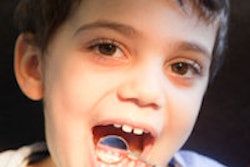
A study comparing four approaches for identifying children younger than 3 years old who are at significant risk for developing early childhood caries (ECC) has found that a salivary culture of mutans streptococci (MS) alone was the most accurate and clinically useful.
The other methods tested in the study were the American Academy of Pediatric Dentistry's caries risk assessment tool (CAT), CAT minus socioeconomic status, and CAT minus socioeconomic status plus MS (Journal of the American Dental Association, July 2012, Vol. 143:7, pp. 756-763).
"The clinical implications in our community go beyond the walls of the dental office to, potentially, Head Start centers and pediatrician colleagues," Richard Yoon, DDS, the study's lead author, said in an interview with DrBicuspid.com. "The idea being that if we are able to identify the high-risk individual within a high-risk community early enough, there is opportunity for the pediatric dentist to provide early intervention and possibly avoid pain, discomfort, risk of infection associated with cavities, and perhaps the advanced techniques that are required to safely and effectively care for a very young child with cavities."
“The clinical implications ... go beyond the walls of the dental office.”
— Richard Yoon, DDS, Columbia University School of Dentistry
For the study, the authors screened 229 children younger than 3 who had ECC and 242 children who did not have them. "The whole process started in 2004 and we began in 2006," noted Dr. Yoon, an associate professor at the Columbia University School of Dentistry. The study was performed at a clinic serving the northern part of Manhattan: Harlem, Washington Heights, and Inwood. All participants had never been to a dentist and all still had all four maxillary primary incisors.
In the course of the study, a dental assistant gathered information to complete the CAT. The researchers then assessed the child's visible plaque and evidence of decalcification and caries, in addition to collecting saliva samples. They assigned plaque scores to the child's four teeth and classified them as having or not having caries.
MS levels were ascertained with unstimulated saliva samples gathered using a tongue depressor. After being pressed into an MS-selective agar medium, the samples were incubated for 48 hours. Afterward, the presence of MS on each sample plate was categorized as low, moderate, or high based on the number of characteristic colony-forming units.
Subjects determined to be of high risk for caries per the CAT assessment were scheduled for a three-month follow-up exam. Low- to moderate-risk participants were scheduled for a six-month follow-up. Those who already had caries were scheduled for the treatment they needed.
New techniques emerging
After analyzing the results, the researchers determined variation in the test accuracy among the different caries-risk assessment approaches. "Although the CAT risk assessment without the optional MS screening measure was highly sensitive (100%), it lacked specificity (2.9%)," they wrote. It improved (69%) when they removed the socioeconomic status criterion. "Overall, clinical usefulness was highest for MS, with a positive predictive value of 93% and a negative predictive value of 88%."
In terms of accuracy and clinical usefulness in a population of low-income children with a caries prevalence of 49%, they concluded that MS is the best screening tool.
The study did have some limitations, the researchers noted. First and foremost, the majority of study participants were individuals from low-income, primarily Hispanic backgrounds, many of whom were children of immigrants. Additionally, the caries prevalence of this group was higher than the national average.
While praising CAT, the researchers also acknowledged its limitations within the context of the study's population.
"Conceptually, the CAT provides a comprehensive and well-ordered educational framework," the researchers wrote. "However, the CAT incorporates both population-level and individual-level factors and, therefore, is not practical to use in low-income populations because all children from low-income families are classified automatically as being at high risk."
Doug Young, DDS, a caries prevention, detection, and management researcher at the University of the Pacific School of Dentistry, applauded the work of the researchers but noted that new advancements in caries detection have arrived since the study was initiated.
"It was a well-written paper," Dr. Young told DrBicuspid.com. "I did notice that it was started several years ago and, like most good studies, it took several years to complete. Since then, there's been some new research out there with prediction methods that may be as effective or better."
For example, a study from Oregon Health & Science University's School of Dentistry found that adenosine triphosphate (ATP)-driven bioluminescence could be an even better means of detecting ECC, Dr. Young noted.
"In their conclusions of the JADA study, MS is the best screening tool," Dr. Young said. "At the time of the study, that probably would be true. Then the ATP study came out."
Editor's note: In part 2 of this report, we will examine studies that focus on ATP bioluminescence as a means of predicting caries.



















